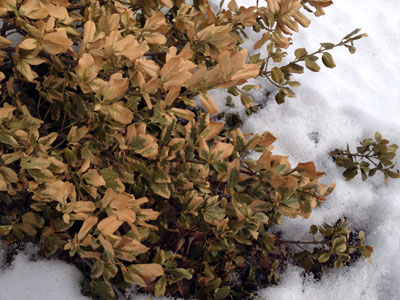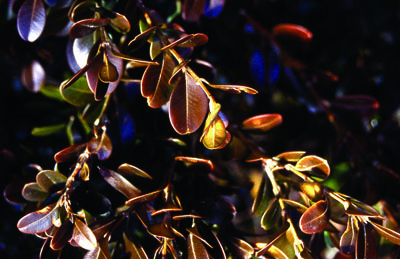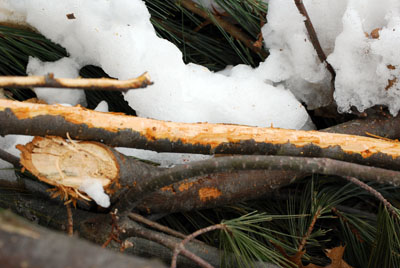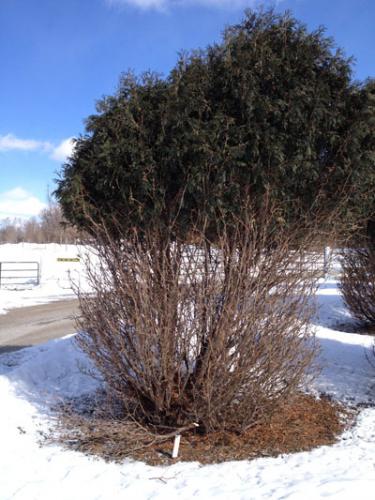Winter tree and shrub injury: What are the signs?
Look for signs of winter damage on trees, shrubs and perennials; plan your home landscape management strategies accordingly.
Home gardeners may notice signs of winter injury within their landscapes due to winter’s extreme temperatures, increased snowfalls, and wind and salt effects. Signs may include broken limbs, cracked bark, browning or loss of needles, browning of broadleaved evergreens, and loss of twigs or bark. Some signs may not even be visible as many shrubs and perennials are still under snow. What are the signs you should be looking for? What, if anything, can be done to prevent further injury? Is there anything a home gardener can do to help these plants survive and return to their original splendor?
Leaf desiccation on broadleaf evergreens
You may be observing browning of leaves on broadleaved evergreens such as azaleas, rhododendrons, hollies, grape-holly, boxwood, euonymous and mountain laurel. (These plants bear leaves that normally stay green all year.) This browning, also known as desiccation, occurs when winter winds draw moisture out of the plant tissue. Since the temperatures have been so extreme, these shallow-rooted plants cannot draw any more water from the frozen ground to replace the water lost by the leaves. You will especially see desiccation on the windward side of plants as the air draws moisture from the leaves as it passes by. If the roots cannot pull up any water, the water that transpired from the leaves cannot be replaced; therefore, these cells die causing brown tissue.
Once the snow melts, you may observe noticeable differences in shrubs or plants that were partially snow-covered. The portion of shrub that was covered in snow was insulated against the colder temperatures and wind, thus will not suffer as severe of signs.

Euonymous suffering from desiccation. Note the leaves under enough snow cover will not suffer from the effects of the cold and wind. Photo credit: Mary Wilson, MSU Extension
Cold temperature damage
A plant’s ability to withstand this winter’s extreme cold also plays a role in the degree of winter injury seen this year. Low-temperature injury will most likely be observed on trees and shrubs planted on the northern fringe or border of their cold hardiness zone rating. Plants with zone five and six cold hardiness ratings will most likely show signs of winter injury if temperatures drop below the “normal” hardiness range or if a plant is not located within a microclimate where temperatures may be more moderated.

Boxwood showing signs of low-temperature injury. Photo credit: Robert Schutzki
Can anything be done to prevent further injury? Unfortunately, prevention of these injuries is best completed before winter. If feasible, attempt to shield broadleaf evergreens with burlap if extended winds and extreme low temperatures are expected to continue. This will only prevent additional tissue from dying; it will not cure the already dead leaves. See the Michigan State University Extension article “Tips for preparing landscape trees and shrubs for winter” to see what you can plan to do next year.
Will these plants survive? Be sure to wait until after shrubs leaf out if you are unsure whether or not a branch is still living. Exposure to this winter’s extreme temperatures may cause delayed leaf development on plants, so if you prune as early as you would after a normal winter, you may be cutting off live growth. The extreme temperatures that we’ve experienced may also cause buds and entire branches to die. Don’t be surprised if you also see some plants start to leaf out but then collapse. Corrective pruning along with recommended fertilization and proper watering will often help these plants recover.
Rodent and deer damage
The high snow falls limit the availability of food for wildlife. Consequently, you may see more girdling of trunks and branches by animals. Check out “Winter snow cover leading to increased rabbit damage for fruit and landscape plants.” If you didn’t fence or protect your plants before winter, voles and rabbits will be feasting on branches that are available above the snow line. With extensive damage to the bark and cambium layer, these plants will not recover. Read “Your plants and winter animal damage” to see how to best prepare against wildlife feasting in your yard.

Example of girdling by rabbits, which is limbs stripped of their bark. Photo credit: Mary Wilson, MSU Extension
You may also notice damage from deer as they find plants in your yard more accessible than in the wild. They may eat parts of or entire plants. For additional information on deer damage and management strategies, see “Gardeners frustrated with heavy deer damage this season.”

Deer damage on Taxus. Photo credit: Mary Wilson, MSU Extension
For more information on a wide variety of Smart Gardening topics, visit the Gardening in Michigan website at www.migarden.msu.edu or contact MSU’s toll-free garden hotline at 1-888-678-3464.



 Print
Print Email
Email


